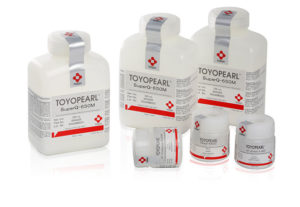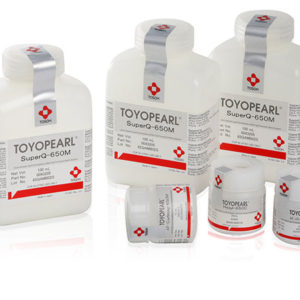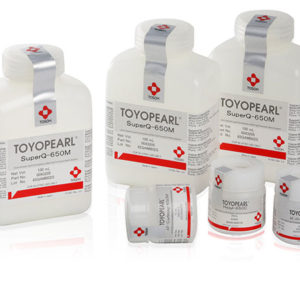Process Media/Resins

Chromatography is a common purification step in industrial downstream processing (DSP) of biological targets. A typical DSP scheme combines two or more chromatographic separation steps with ultra- and diafiltration unit operations to achieve the desired purity for the target. Due to their non-denaturing character, Ion Exchange, Mixed-Mode, Hydrophobic Interaction, Affinity, and Size Exclusion Chromatography are the common modes applied in biopurification.
Chromatography by Mode
Size Exclusion Chromatography
Size Exclusion Chromatography (SEC)
also referred to as gel-filtration chromatography when used with aqueous mobile phases, uses porous particles to separate biological molecules of different sizes. The advantages of this method include good separation of large molecules from the small molecules while preserving the biological activity of the particles to be separated.
Proteins larger than the pore size cannot enter the pores and will thus co-elute as the first peak in the chromatogram. These molecules are said to be totally excluded from the pores. Proteins that at least partially enter the pores will have varying residence times dependent on their hydrodynamic radius. Different proteins will therefore have different residence times when passing through the column. Molecules that are smaller than the pore size are able to enter all of the pores in the resin and will therefore have the longest residence times. These molecules typically elute together as the last peak in a chromatogram.
Ion Exchange Chromatography
Ion Exchange Chromatography (IEC or IEX)
is driven by interactions between charged target molecules and charged immobilized ligands on the chromatography resin. IEX can be divided into two different sub types. Cation exchange chromatography, in which positively charged species in the mobile phase bind to a negatively charged ligand on the resin; and anion exchange chromatography, in which the binding species in the mobile phase are negatively charged, and the immobilized ligand is positively charged.
After the molecule of interest has been adsorbed, the column is washed to remove any residual unbound species from the solid phase. The bound molecules are then desorbed using a gradient of a second, higher ionic strength mobile phase to steadily increase the ionic strength of the eluent solution. An alternative desorption method involves using a mobile phase of greater or lesser pH than the equilibration mobile phase to give your molecule of interest or the ligand a charge at which they will not interact and your molecule of interest elutes from the resin.
Hydrophilic Interaction Chromatography
is a powerful tool for the process purification of biomolecules. The technique utilizes the accessible hydrophobic regions located on protein surfaces and their interactions with a weakly hydrophobic stationary phase. Proteins and other molecules with hydrophobic surfaces are attracted to the hydrophobic ligands of HIC resins by employing an aqueous high salt mobile phase. The salt conditions contribute to a lyotropic effect which allows the proteins to bind to a hydrophobic ligand. Proteins are eluted by decreasing the salt concentration. Most therapeutic targets are eluted in a low salt or a no salt buffer. Since HIC separations are done under mild eluting conditions, biological activity is typically retained.
Mixed Mode Chromatography
Mixed-Mode or Multimodal Chromatography
expands the range of chromatographic modes applied in biopurification. Mixed-Mode media combine ionic and hydrophobic interactions and offer new selectivities and a higher salt tolerance than traditional ion exchange media.
Affinity Chromatography
Affinity Chromatography (AFC)
makes use of specific binding interactions between molecules. This specificity makes it attractive as a capture step to isolate the target molecule from crude extracts. A particular ligand is chemically immobilized to a solid support so that when the crude extract is passed over the column, those molecules having a specific binding affinity to the ligand become adsorbed. After the non-specifically binding components are washed away, the target molecule is desorbed from the support, resulting in its purification from the original sample.
In AFC the mechanism of binding and elution varies depending on the immobilized ligand used. In Protein A chromatography elution is accomplished by decreasing the pH. In other cases such as with Chelate resins (for Immobilized Metal Affinity Chromatography or IMAC) the binding and elution mechanism may change through the use of different metals or chemical modifiers.
Gå til Tosoh Bioscience’s hjemmeside for en samlet oversigt over alle resiner.
For flere detaljer og pris, kontakt venligst MD Scientific via e-mail: info@md-scientific.dk eller telefon: 7027 8565.
Viser alle 2 resultater


